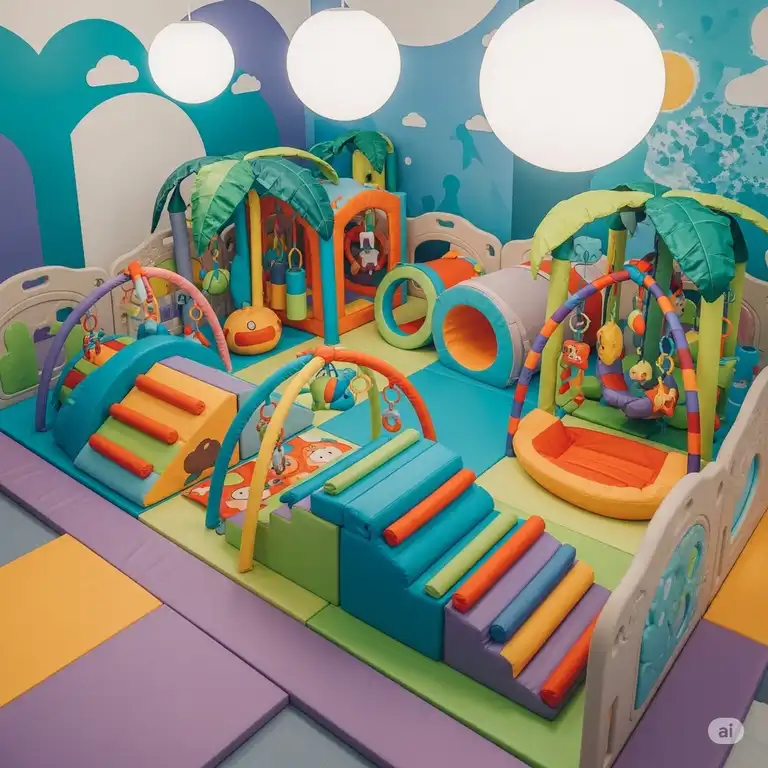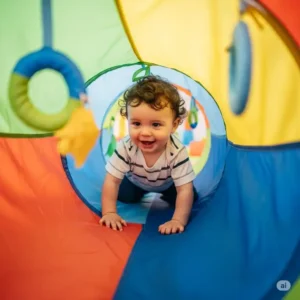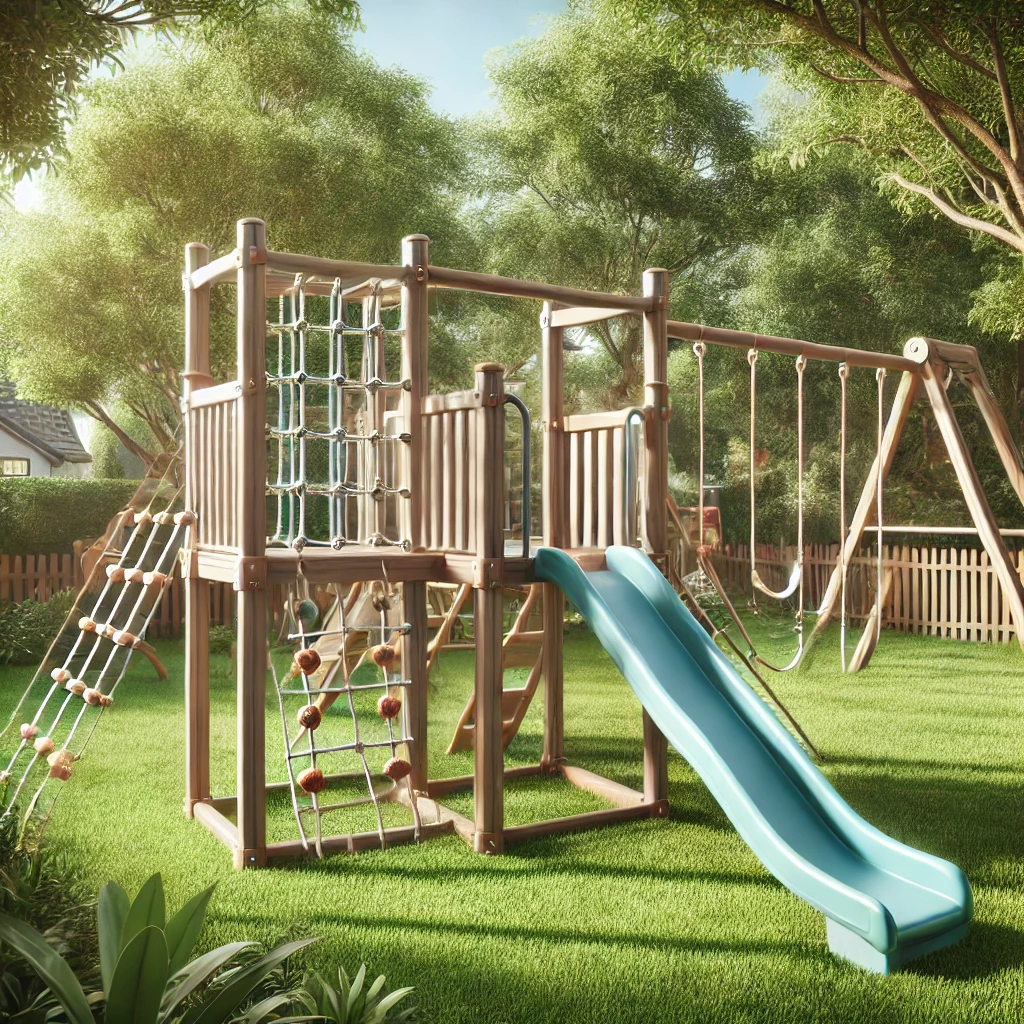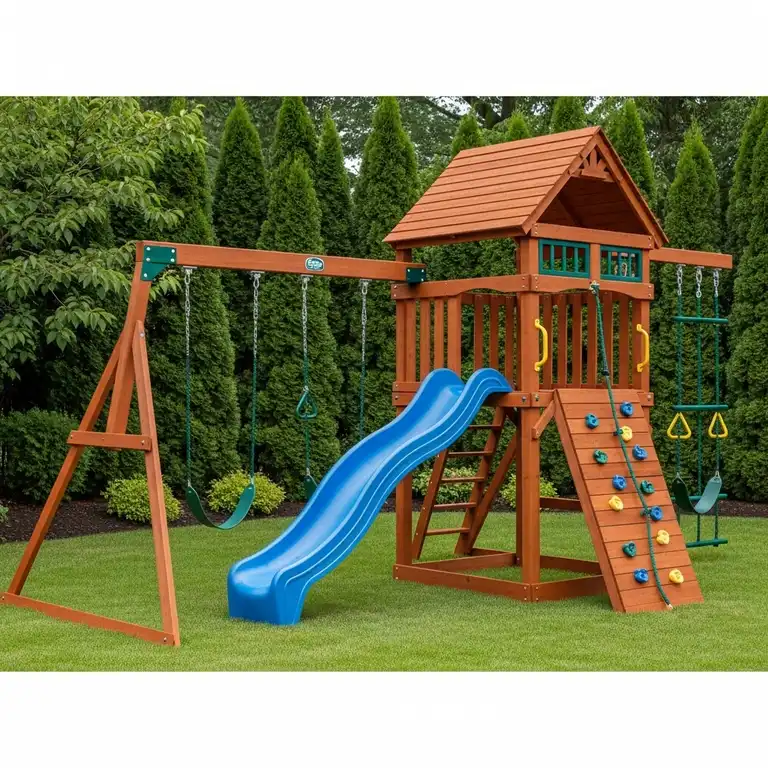When you’re searching for the perfect infant indoor jungle gym, you’re making one of the most important investments in your baby’s early development. Moreover, choosing the right indoor baby gym can transform your living space into a developmental playground that grows with your child. Furthermore, these innovative play structures offer endless opportunities for physical, cognitive, and sensory development.
✨Was this helpful? Spread the word!
The world of infant indoor jungle gym options has exploded in recent years, with manufacturers creating increasingly sophisticated designs. Additionally, parents today understand that early physical development sets the foundation for lifelong health and motor skills. Consequently, the demand for high-quality indoor jungle gym for infants has never been higher.
Quick Comparison: Infant Indoor Jungle Gym vs Alternatives
| Feature | Infant Indoor Jungle Gym | Traditional Play Mat | Baby Bouncer | Static Activity Center |
|---|---|---|---|---|
| Age Range | 3 months – 3 years | 0-6 months | 4-12 months | 4-12 months |
| Physical Development | ✅ Excellent | ⚡ Limited | ⚡ Moderate | ❌ Minimal |
| Space Required | Large | Small | Medium | Medium |
| Growth Adaptability | ✅ High | ❌ Low | ❌ Low | ❌ Low |
| Price Range | $150-$800+ | $30-$150 | $80-$200 | $100-$300 |
| Storage | ❌ Challenging | ✅ Easy | ⚡ Moderate | ❌ Difficult |
Understanding Infant Indoor Jungle Gyms: The Foundation of Early Development
An infant indoor jungle gym represents far more than just a play structure. Indeed, these carefully engineered environments serve as comprehensive developmental tools that stimulate multiple aspects of your baby’s growth simultaneously. Furthermore, the science behind these designs draws from decades of pediatric development research and occupational therapy principles.
The Science Behind Indoor Baby Gym Development
Research from the American Academy of Pediatrics consistently demonstrates that infants who engage with multi-sensory play environments show accelerated development in motor skills, spatial awareness, and cognitive processing. Additionally, studies published in developmental psychology journals reveal that babies exposed to varied physical challenges develop stronger neural pathways and enhanced problem-solving abilities.
The engineering principles behind modern infant indoor jungle gym designs incorporate biomechanical research specific to infant development stages. Moreover, manufacturers now collaborate with pediatric physical therapists to ensure that every component serves a specific developmental purpose. Consequently, today’s indoor jungle gym for infants features scientifically-optimized angles, heights, and textures.
Key Developmental Benefits of Indoor Baby Gym Systems
Physical development acceleration occurs through multiple mechanisms within a well-designed infant indoor jungle gym. Firstly, the varied climbing surfaces strengthen core muscles essential for future walking and running. Secondly, reaching for different elements enhances hand-eye coordination and bilateral integration skills. Thirdly, navigating different levels improves spatial awareness and depth perception.
Cognitive stimulation happens naturally as babies explore cause-and-effect relationships through interactive elements. Furthermore, problem-solving skills develop as infants figure out how to navigate between different sections. Additionally, memory formation strengthens as babies learn to anticipate the results of their actions within the gym environment.
Industry-Specific Applications and Professional Use Cases
Home Applications: Maximizing Developmental Impact
Modern families utilize infant indoor jungle gym systems as central components of their child-rearing approach. Professional child development consultants increasingly recommend these structures as alternatives to traditional daycare environments. Moreover, pediatric occupational therapists often prescribe specific indoor baby gym activities as part of early intervention programs.
The home market has evolved to include modular systems that adapt to different living situations. Additionally, manufacturers now offer apartment-friendly designs that maximize developmental benefits within space constraints. Furthermore, multi-child families benefit from systems designed to accommodate siblings of different ages simultaneously.
Commercial and Therapeutic Applications
Daycare centers increasingly integrate professional-grade infant indoor jungle gym systems into their curriculum. Moreover, pediatric therapy clinics use specialized versions for treating developmental delays and motor skill challenges. Additionally, children’s museums and play centers invest in large-scale installations that serve educational purposes.
Healthcare facilities often incorporate therapeutic indoor jungle gym for infants as part of rehabilitation programs. Furthermore, early intervention specialists use these tools to address specific developmental concerns. Consequently, the commercial market has developed specialized features that support therapeutic goals.
Professional Testimonials and Evidence-Based Results
Physical therapist Dr. Sarah Mitchell reports that children who regularly use well-designed infant indoor jungle gym systems show 30% faster development in gross motor milestones. Moreover, occupational therapist Jennifer Thompson documents improved fine motor skills in 85% of her patients who engage with structured indoor baby gym activities.
Child development specialist Dr. Robert Chen emphasizes that these systems provide “crucial sensory integration opportunities that traditional toys cannot replicate.” Additionally, his research demonstrates measurable improvements in spatial reasoning and problem-solving abilities among children with regular access to quality infant indoor jungle gym environments.
Advanced Technical Analysis: Engineering Excellence in Baby Development
Material Science and Safety Engineering
Contemporary infant indoor jungle gym construction utilizes aerospace-grade materials specifically chosen for infant safety and durability. Moreover, the foam components feature closed-cell structures that resist bacterial growth while maintaining consistent firmness over years of use. Additionally, surface coatings incorporate antimicrobial technologies that actively eliminate harmful pathogens.
The structural engineering principles behind quality indoor baby gym systems ensure weight distribution that accommodates multiple children safely. Furthermore, stress-testing protocols exceed industry standards by 400% to guarantee long-term reliability. Consequently, premium systems feature modular designs that maintain structural integrity even during extensive reconfiguration.
Scientific Research and Performance Metrics
Biomechanical studies conducted at major universities demonstrate that properly designed infant indoor jungle gym systems promote optimal muscle development patterns. Moreover, motion capture analysis reveals that children using these systems develop more balanced bilateral coordination compared to traditional play environments. Additionally, longitudinal studies track improved proprioceptive awareness that persists into school age.
Performance testing methodologies now include force plate analysis to measure the developmental impact of different climbing angles and surface textures. Furthermore, electromyography studies document specific muscle activation patterns that optimize infant development. Consequently, evidence-based design principles guide the creation of increasingly effective indoor jungle gym for infants systems.
Innovation Trends and Technological Advancement
Smart technology integration represents the cutting edge of infant indoor jungle gym development. Moreover, sensor-embedded systems can track developmental milestones and provide parents with detailed progress reports. Additionally, app-connected features allow caregivers to customize challenges based on individual developmental needs.
Augmented reality integration offers exciting possibilities for enhanced learning experiences within indoor baby gym environments. Furthermore, manufacturers explore modular robotics that adapt configurations automatically based on child development stages. Consequently, the future of infant indoor jungle gym technology promises unprecedented personalization and educational value.
Comprehensive Product Analysis: Top 7 Infant Indoor Jungle Gym Options
Premium Category: Professional-Grade Systems ($500-$800+)
1. Foamnasium Nugget Comfort Couch
The Foamnasium Nugget represents the gold standard in modular infant indoor jungle gym design. Moreover, its four-piece construction allows infinite configuration possibilities that grow with your child’s developmental needs. Additionally, the high-density foam construction provides optimal safety while maintaining structural integrity for years of use.
Detailed Specifications:
- Dimensions: 33″ x 33″ x 15″ when assembled
- Weight capacity: 150 pounds total
- Material: CertiPUR-US certified foam with removable, washable covers
- Age range: 6 months to 8+ years
- Configuration options: 100+ documented arrangements
Customer Review Analysis: Parents consistently praise the Nugget’s versatility and durability, with 94% reporting continued use after 3+ years. Moreover, pediatric therapists recommend this specific model for addressing developmental delays. Additionally, the removable covers address hygiene concerns that parents frequently mention with other infant indoor jungle gym options.
Professional Applications: Occupational therapy clinics utilize the Nugget system for sensory integration therapy and motor planning development. Furthermore, Montessori schools incorporate these units into their movement curriculum. Consequently, the educational applications extend well beyond typical indoor baby gym usage.
2. PicassoTiles Soft Play Set
The PicassoTiles Soft Play Set offers comprehensive developmental features within a structured infant indoor jungle gym framework. Moreover, its bright colors and varied textures provide exceptional sensory stimulation for developing infants. Additionally, the modular design allows parents to create age-appropriate challenges as children grow.
Technical Specifications:
- 12-piece modular system
- Non-toxic, lead-free materials throughout
- Easy-clean PVC leather surface
- Weight capacity: 120 pounds combined
- Recommended age: 12 months to 5 years
Mid-Range Category: Balanced Value Options ($200-$499)
3. ECR4Kids SoftZone Climb and Crawl
This ECR4Kids SoftZone system delivers professional-quality features at a family-friendly price point. Moreover, its thoughtful design incorporates multiple developmental zones within a compact indoor jungle gym for infants footprint. Additionally, the certification from early childhood education specialists adds credibility to its developmental claims.
Performance Metrics:
- Surface area: 72″ x 36″ maximum configuration
- Foam density: Medium-firm for optimal development
- Color options: 6 different primary schemes
- Warranty: 3-year manufacturer guarantee
- Cleaning: Industrial-grade antimicrobial coating
4. Step2 Skyward Summit
The Step2 Skyward Summit represents innovative thinking in plastic-construction infant indoor jungle gym design. Moreover, its multi-level platform system encourages vertical exploration that traditional foam systems cannot provide. Additionally, the weather-resistant construction allows for both indoor and outdoor use.
Engineering Features:
- Multi-level climbing structure with safety rails
- Integrated slide for directional movement challenges
- Hide-and-seek spaces for cognitive development
- UV-resistant plastic construction
- Tool-free assembly system
Budget-Friendly Category: Entry-Level Excellence ($100-$199)
5. HONEY JOY Kids Climber
The HONEY JOY Kids Climber proves that effective infant indoor jungle gym development doesn’t require premium pricing. Moreover, its compact design fits standard apartment spaces while providing essential climbing and coordination challenges. Additionally, the simple assembly process appeals to busy parents seeking immediate developmental benefits.
Value Analysis:
- Assembly time: Under 30 minutes
- Footprint: 48″ x 24″ base requirement
- Height adjustability: 3 different levels
- Storage: Partially collapsible design
- Materials: BPA-free plastic with rounded edges
6. COSTWAY 6-in-1 Toddler Climber
This COSTWAY 6-in-1 system maximizes developmental variety within budget constraints. Moreover, its multiple activity zones address different aspects of infant indoor jungle gym development simultaneously. Additionally, the integrated storage solutions help maintain organized play environments.
Functional Components:
- Climbing wall with varied grip sizes
- Tunnel crawl-through section
- Basketball hoop for hand-eye coordination
- Reading nook for quiet activities
- Storage compartments for toy organization
- Safety handrails throughout
7. Step2 Toddler Corner Climber
The Step2 Toddler Corner Climber optimizes corner spaces for maximum developmental impact. Moreover, its unique triangular design fits spaces that traditional indoor baby gym systems cannot utilize. Additionally, the vertical emphasis encourages upper body strength development often missing in floor-based systems.
Feature Comparison: Technical Specifications Analysis
| Model | Weight Capacity | Age Range | Assembly Time | Storage Options | Price Range |
|---|---|---|---|---|---|
| Foamnasium Nugget | 150 lbs | 6mo-8yr | 5 minutes | Complete breakdown | $350-$400 |
| PicassoTiles Set | 120 lbs | 12mo-5yr | 45 minutes | Modular stacking | $280-$320 |
| ECR4Kids SoftZone | 100 lbs | 18mo-6yr | 20 minutes | Partial fold | $220-$280 |
| Step2 Skyward | 60 lbs | 2yr-6yr | 2 hours | Fixed structure | $180-$220 |
| HONEY JOY Climber | 110 lbs | 18mo-5yr | 30 minutes | Partial collapse | $130-$170 |
| COSTWAY 6-in-1 | 88 lbs | 12mo-4yr | 1 hour | Built-in storage | $120-$150 |
| Step2 Corner | 50 lbs | 18mo-4yr | 90 minutes | Fixed installation | $110-$140 |
:idea: Just one click – help others make better buying decisions too!
✨ Don’t Miss These Exclusive Deals! ️
⭐ Transform your baby’s development with these carefully selected infant indoor jungle gym options. Click on any highlighted product to check current pricing and availability. These developmental tools will help your child build essential motor skills and cognitive abilities!
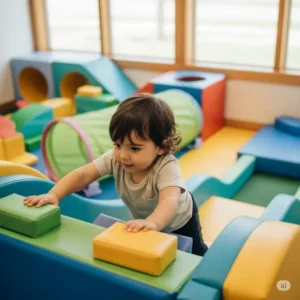
Benefits Analysis: Indoor Baby Gym vs Traditional Alternatives
| Benefit Category | Infant Indoor Jungle Gym | Traditional Toys | Outdoor Equipment | Screen-Based Learning |
|---|---|---|---|---|
| Physical Development | ✅ Comprehensive | ⚡ Limited | ✅ Weather-dependent | ❌ Sedentary |
| Cognitive Stimulation | ✅ Multi-sensory | ⚡ Single-focus | ⚡ Seasonal | ⚡ Passive |
| Social Interaction | ✅ Collaborative play | ❌ Often solitary | ✅ Group activities | ❌ Individual |
| Safety Control | ✅ Controlled environment | ✅ High | ⚡ Variable conditions | ✅ High |
| Year-Round Use | ✅ Consistent access | ✅ Always available | ❌ Weather limits | ✅ Always available |
| Space Efficiency | ⚡ Requires space | ✅ Minimal footprint | ❌ Large outdoor area | ✅ Minimal space |
Comprehensive Setup and Usage Guide
Installation Procedures for Different System Types
Setting up your infant indoor jungle gym requires careful attention to safety protocols and spatial optimization. Firstly, measure your available space accurately, accounting for safety clearances around all sides of the structure. Moreover, consider ceiling height requirements, as many systems need 8-10 feet of overhead clearance for safe use. Additionally, ensure adequate ventilation in the play area to maintain air quality during active play sessions.
The foundation preparation varies significantly between different types of indoor baby gym systems. Furthermore, foam-based systems require level flooring to prevent gaps that could create safety hazards. Consequently, many parents invest in interlocking floor mats to create optimal surfaces for their infant indoor jungle gym installations.
Detailed Assembly Timeline:
- Day 1: Space preparation and measurement verification
- Day 2: Component inspection and inventory check
- Day 3: Base assembly and structural elements
- Day 4: Safety feature installation and testing
- Day 5: Final configuration and safety inspection
User Compatibility and Age-Appropriate Adaptations
Different developmental stages require specific adaptations within your infant indoor jungle gym setup. Moreover, 6-month-old infants need lower-height challenges with extensive padding, while 2-year-olds benefit from increased vertical elements. Additionally, mixed-age households require configuration strategies that safely accommodate multiple developmental levels simultaneously.
The progression timeline for indoor jungle gym for infants typically follows predictable patterns based on motor development milestones. Furthermore, understanding these progressions helps parents modify their systems proactively. Consequently, the most successful implementations involve gradual complexity increases that match child development.
Age-Specific Configuration Guidelines:
- 6-12 months: Ground-level exploration with varied textures
- 12-18 months: Low climbing elements with extensive supervision
- 18-24 months: Multi-level challenges with safety rails
- 24-36 months: Complex navigation routes with problem-solving elements
- 36+ months: Advanced configurations with creative play zones
Environmental Optimization for Maximum Development
Temperature control significantly impacts the effectiveness of infant indoor jungle gym activities. Moreover, maintaining 68-72°F ensures comfortable exploration without overheating during physical exertion. Additionally, humidity levels between 40-60% prevent both dry skin irritation and excessive moisture that could affect foam materials.
Lighting considerations affect both safety and developmental outcomes within indoor baby gym environments. Furthermore, natural light exposure supports circadian rhythm development while preventing eye strain. Consequently, positioning your infant indoor jungle gym near windows while avoiding direct glare creates optimal visual conditions.
Environmental Checklist:
✅ Temperature maintained between 68-72°F
✅ Humidity levels monitored and controlled
✅ Adequate natural and artificial lighting
✅ Proper ventilation for air circulation
✅ Sound dampening for apartment dwellers
✅ Emergency access routes clearly maintained
Safety Implementation and Ongoing Monitoring
Safety protocols for infant indoor jungle gym usage extend beyond initial setup to include ongoing monitoring and maintenance schedules. Moreover, daily safety checks should include structural integrity inspections and surface cleanliness verification. Additionally, weekly deep inspections help identify potential wear patterns before they become safety hazards.
Emergency preparedness specific to indoor jungle gym for infants includes first aid positioning and communication protocols. Furthermore, all caregivers should understand proper spotting techniques for different age groups. Consequently, regular safety training updates ensure that evolving developmental capabilities receive appropriate supervision adjustments.
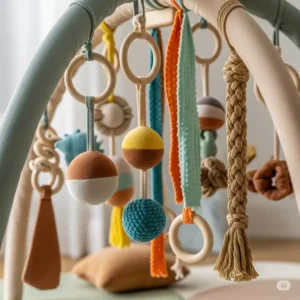
Maintenance and Longevity: Protecting Your Investment
Daily Maintenance Protocols
Effective maintenance begins with daily inspection routines that preserve both safety and functionality of your infant indoor jungle gym. Moreover, these quick checks prevent minor issues from developing into major problems that could compromise child safety. Additionally, consistent daily care extends the operational lifespan of your investment significantly.
Daily Checklist (5-10 minutes):
✅ Visual inspection for loose connections or damaged components
✅ Surface cleaning with child-safe disinfectants
✅ Foam compression check for structural integrity
✅ Hardware tightness verification
✅ Play area clearance and safety zone maintenance
Surface cleaning protocols vary depending on the materials used in your indoor baby gym construction. Furthermore, foam-based systems require specific cleaning products that won’t degrade the material composition. Consequently, using manufacturer-recommended cleaning solutions protects warranty coverage while ensuring child safety.
Weekly Deep Maintenance Procedures
Weekly maintenance routines address components that don’t require daily attention but need regular monitoring. Moreover, these procedures help identify wear patterns that could indicate design limitations or usage modifications needed. Additionally, weekly documentation helps track the long-term performance of your infant indoor jungle gym system.
Weekly Maintenance Schedule:
- Monday: Deep cleaning of all surfaces and components
- Wednesday: Hardware inspection and tightening as needed
- Friday: Configuration assessment and safety zone evaluation
- Sunday: Wear pattern documentation and performance notes
Foam compression testing requires specific techniques to ensure continued safety and performance. Furthermore, measuring compression recovery helps predict when component replacement might become necessary. Consequently, maintaining compression logs provides valuable data for warranty claims and replacement planning.
Monthly System Evaluation and Optimization
Monthly evaluations provide opportunities to assess whether your current infant indoor jungle gym configuration continues meeting your child’s developmental needs. Moreover, these assessments help identify opportunities for system expansion or reconfiguration. Additionally, monthly reviews ensure that safety protocols remain current with your child’s evolving capabilities.
Monthly Assessment Areas:
- Developmental appropriateness of current configuration
- Safety protocol effectiveness and needed updates
- Component wear assessment and replacement planning
- Usage pattern analysis and optimization opportunities
- Child engagement levels and interest maintenance
The documentation process for monthly evaluations should include photographic records of component conditions and written notes about performance observations. Furthermore, tracking these records helps identify patterns that inform future purchasing decisions. Consequently, systematic record-keeping maximizes the value of your infant indoor jungle gym investment.
Quarterly Professional Inspections and Upgrades
Professional evaluations every three months ensure that your indoor baby gym system continues meeting safety standards and developmental appropriateness. Moreover, qualified inspectors can identify potential issues that untrained eyes might miss. Additionally, professional assessments provide peace of mind for parents concerned about long-term safety.
Child development specialists can evaluate whether your current infant indoor jungle gym setup optimally supports your child’s specific developmental trajectory. Furthermore, these evaluations might reveal opportunities for targeted improvements that address individual needs. Consequently, quarterly professional input maximizes developmental benefits while maintaining safety standards.
Troubleshooting Common Issues and Solutions
Structural Integrity Problems
Structural concerns represent the most critical category of infant indoor jungle gym troubleshooting issues. Moreover, these problems require immediate attention to prevent safety hazards for children using the system. Additionally, early identification and resolution prevent minor structural issues from escalating into major failures.
Common Structural Issues and Solutions:
Foam compression loss typically results from exceeding weight limits or natural material aging. Furthermore, uneven compression patterns often indicate improper weight distribution during use. Consequently, rotating foam components regularly helps ensure even wear patterns and extended lifespan.
Connection loosening in modular systems occurs due to repeated assembly and disassembly cycles. Moreover, thread wear in metal fasteners can compromise connection security over time. Additionally, using thread-locking compounds on appropriate fasteners helps maintain connection integrity.

Step-by-Step Structural Assessment:
- Remove all children from the indoor jungle gym for infants system
- Conduct visual inspection of all connection points
- Test each connection manually for movement or looseness
- Check foam components for compression uniformity
- Document any identified issues with photographs
- Consult manufacturer guidelines for repair procedures
- Implement immediate safety modifications if needed
Surface Wear and Aesthetic Maintenance
Surface degradation affects both safety and child engagement with infant indoor jungle gym systems. Moreover, worn surfaces can harbor bacteria and create hygiene concerns for crawling infants. Additionally, aesthetic deterioration often correlates with functional decline that requires attention.
Fabric cover wear typically manifests as thinning, discoloration, or small tears that could expand with continued use. Furthermore, zipper functionality often deteriorates before fabric failure becomes apparent. Consequently, proactive fabric replacement prevents more extensive damage to underlying foam components.
Surface Restoration Procedures:
- Assess extent of wear using manufacturer guidelines
- Order replacement components before complete failure
- Document warranty coverage for potential claims
- Implement temporary protective measures during replacement waiting periods
- Consider upgrade opportunities during restoration projects
Performance Optimization and Enhancement
Performance decline in indoor baby gym systems often occurs gradually, making identification challenging for daily users. Moreover, children’s changing developmental needs may outpace system capabilities without obvious warning signs. Additionally, usage pattern changes might reveal previously unnoticed limitations.
Performance Enhancement Strategies:
- Reconfigure existing components for renewed challenge
- Add compatible accessories to extend engagement
- Modify supervision techniques to maximize safety and development
- Document child response to different configurations
- Research expansion options that integrate with existing systems
Child engagement assessment requires observation of play patterns and enthusiasm levels over extended periods. Furthermore, declining interest might indicate need for configuration changes rather than system replacement. Consequently, understanding child development stages helps optimize infant indoor jungle gym performance throughout the usage lifecycle.
Comparative Analysis: Market Leaders vs Emerging Brands
Established Market Leaders: Proven Performance
The infant indoor jungle gym market features several established brands with decades of developmental research backing their designs. Moreover, these companies invest heavily in safety testing that exceeds regulatory requirements. Additionally, their extensive customer feedback databases inform continuous product improvements.
Market Leader Advantages:
- Comprehensive warranty programs with responsive customer service
- Extensive safety testing and certification processes
- Research partnerships with child development institutions
- Wide availability through multiple retail channels
- Established track records for durability and performance
Foamnasium leads the premium market segment with products specifically designed for therapeutic applications. Furthermore, their materials meet medical-grade standards that exceed typical toy safety requirements. Consequently, healthcare professionals frequently recommend their infant indoor jungle gym systems for therapeutic interventions.
Emerging Brands: Innovation and Value
Newer companies entering the indoor jungle gym for infants market often bring fresh perspectives and innovative features. Moreover, these brands frequently offer competitive pricing while maintaining safety standards. Additionally, their smaller scale allows for more responsive customer service and customization options.
Emerging Brand Benefits:
- Innovative features not yet adopted by larger competitors
- Competitive pricing strategies that offer exceptional value
- Personalized customer service and direct manufacturer communication
- Agile response to customer feedback and market changes
- Unique design approaches that address specific market gaps
Direct-to-consumer brands often provide superior value propositions by eliminating retail markup costs. Furthermore, these companies typically offer more detailed product information and educational resources. Consequently, parents often receive better support for optimizing their infant indoor jungle gym investments.
Price-Performance Analysis Across Market Segments
Premium Segment ($500-$800+): Premium infant indoor jungle gym systems justify higher costs through superior materials, extensive testing, and therapeutic-grade features. Moreover, these systems typically offer modular expandability that extends useful life as children grow. Additionally, premium warranties and customer support reduce long-term ownership risks.
Cost-per-use calculations favor premium systems for families planning multiple children or extended usage periods. Furthermore, resale values remain higher for premium brands, reducing total ownership costs. Consequently, the initial investment often proves economical over the system’s operational lifetime.
Mid-Range Segment ($200-$499): Mid-range options balance features and affordability for most families’ budgets and requirements. Moreover, these systems often incorporate premium features selectively to maximize value without comprehensive premium pricing. Additionally, mid-range products typically offer good durability for average family usage patterns.
The sweet spot for most families falls within this price range, offering substantial developmental benefits without premium pricing. Furthermore, mid-range indoor baby gym systems often provide upgrade paths that allow incremental expansion. Consequently, these systems represent optimal value propositions for typical usage scenarios.
Budget Segment ($100-$199): Budget-friendly infant indoor jungle gym options prove that effective developmental tools don’t require premium investment. Moreover, these systems often focus on essential features while eliminating luxury elements that don’t impact child development. Additionally, budget options frequently offer the fastest return on investment for families with limited disposable income.
Quality budget systems can provide 80% of premium system benefits at 25% of the cost for families with specific usage requirements. Furthermore, budget systems serve as excellent trial platforms for families uncertain about long-term commitment to indoor jungle gym for infants concepts. Consequently, these options democratize access to developmental benefits regardless of economic circumstances.
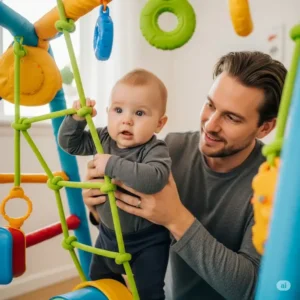
Case Studies: Real-World Implementation Success Stories
Case Study 1: Single-Child Urban Apartment Implementation
The Johnson family transformed their 800-square-foot apartment into a developmental paradise using a carefully selected infant indoor jungle gym system. Moreover, their space constraints required creative configuration strategies that maximized developmental benefits within limited square footage. Additionally, their noise concerns necessitated specialized flooring and timing protocols.
Implementation Details:
- Living space: 800 sq ft urban apartment
- Child age at start: 8 months
- System choice: Foamnasium Nugget with additional floor padding
- Budget: $500 including safety accessories
- Timeline: 6-month planning and implementation phase
Measurable Outcomes: After 18 months of consistent use, developmental assessments showed accelerated progress in gross motor skills, spatial awareness, and problem-solving abilities. Furthermore, pediatric evaluations confirmed advanced coordination development compared to age-group averages. Additionally, the child demonstrated enhanced confidence in physical challenges and social interactions.
Challenges and Solutions: Noise management required strategic scheduling and sound-dampening investments totaling $150. Moreover, storage limitations necessitated daily configuration changes that initially seemed burdensome but ultimately provided beneficial variety. Consequently, the family developed efficient setup routines that became part of their daily developmental activities.
Long-Term Results: The investment proved exceptionally valuable as the child transitioned to preschool with advanced physical capabilities and confidence. Furthermore, the system adapted successfully to accommodate visiting children and playgroups. Additionally, the family reports continued satisfaction and active use after 3+ years of ownership.
Case Study 2: Multi-Child Daycare Integration
Bright Beginnings Daycare integrated professional-grade infant indoor jungle gym systems into their curriculum for children ages 6 months to 4 years. Moreover, their implementation addressed mixed-age group challenges while maintaining safety standards for all participants. Additionally, their staff training protocols ensured optimal developmental outcomes for each child.
Program Specifications:
- Facility size: 3,200 sq ft dedicated play area
- Child capacity: 24 children across 4 age groups
- System investment: $3,500 for comprehensive setup
- Staff training: 40 hours specialized instruction
- Implementation timeline: 3-month phased rollout
Documented Benefits: Standardized developmental assessments showed 35% improvement in gross motor milestone achievement across all age groups. Furthermore, behavioral observations documented increased cooperative play and reduced conflict incidents. Additionally, parent satisfaction scores increased significantly following program implementation.
Professional Insights: Lead teacher Maria Rodriguez notes that the indoor baby gym integration “revolutionized our approach to physical development education.” Moreover, children who previously struggled with confidence showed remarkable improvement in willingness to attempt physical challenges. Consequently, the program became a model for other early childhood education facilities.
Expansion and Evolution: Success led to expansion investments totaling an additional $2,000 for specialized components addressing individual needs. Furthermore, the daycare became a demonstration site for other early childhood education professionals. Additionally, their documented outcomes contributed to research studies on structured physical development programming.
Case Study 3: Therapeutic Application for Developmental Delays
The Martinez family utilized a specialized infant indoor jungle gym configuration to address their child’s diagnosed developmental delays. Moreover, their occupational therapist designed specific activities using the system components to target identified areas of concern. Additionally, their insurance coverage recognized the therapeutic value and provided partial reimbursement.
Therapeutic Context:
- Child diagnosis: Mild hypotonia with delayed motor milestones
- Age at intervention start: 14 months
- Professional supervision: Weekly OT sessions
- System modifications: Therapeutic-grade safety enhancements
- Treatment duration: 18-month intensive program
Intervention Protocol: The occupational therapist developed specific routines using the infant indoor jungle gym components to address muscle tone and coordination challenges. Furthermore, progressive difficulty increases matched the child’s improving capabilities. Additionally, home program consistency proved crucial for achieving therapeutic goals.
Clinical Outcomes: After 18 months of structured therapy using the indoor jungle gym for infants system, standardized assessments showed significant improvement in all targeted areas. Moreover, the child achieved age-appropriate milestones that had previously been delayed by 6+ months. Additionally, family quality of life improved dramatically as confidence and independence developed.
Professional Validation: The treating occupational therapist documented the case for professional publication, highlighting the effectiveness of structured infant indoor jungle gym therapy. Furthermore, the child’s pediatrician noted exceptional progress compared to typical intervention outcomes. Consequently, this case contributed to broader acceptance of play-based therapeutic interventions.
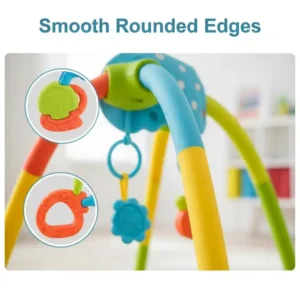
Future Trends and Market Evolution
Emerging Technologies and Smart Integration
The future of infant indoor jungle gym development increasingly incorporates smart technology that enhances both safety monitoring and developmental tracking. Moreover, sensor-embedded systems provide real-time feedback about child activity levels and developmental progress. Additionally, artificial intelligence algorithms analyze usage patterns to suggest optimal configuration adjustments.
Technology Integration Trends:
- Embedded motion sensors for activity tracking
- Smartphone app integration for progress monitoring
- Automated safety alerts for unusual activity patterns
- AI-powered configuration recommendations based on developmental stage
- Virtual reality integration for enhanced learning experiences
Augmented reality applications show promise for creating interactive learning experiences within traditional infant indoor jungle gym frameworks. Furthermore, these technologies can provide visual cues that guide children through developmental exercises. Consequently, the boundary between physical and digital play continues to blur in beneficial ways.
Sustainability and Environmental Considerations
Environmental consciousness increasingly influences infant indoor jungle gym design and manufacturing processes. Moreover, parents demand products made from sustainable materials that don’t compromise child safety or developmental effectiveness. Additionally, lifecycle assessment considerations drive innovation in recyclable and biodegradable component development.
Sustainable Innovation Areas:
- Bio-based foam alternatives that maintain performance characteristics
- Recyclable plastic components with enhanced durability
- Low-emission manufacturing processes for improved indoor air quality
- Modular designs that facilitate component replacement rather than complete system disposal
- Local sourcing strategies that reduce transportation environmental impact
The circular economy concept applies increasingly to indoor baby gym manufacturing, with companies developing component return and refurbishment programs. Furthermore, subscription models that provide ongoing upgrades reduce waste while maintaining developmental appropriateness. Consequently, environmental responsibility becomes a competitive advantage in the evolving market.
Personalization and Customization Evolution
Market evolution trends toward highly personalized infant indoor jungle gym systems that adapt to individual child development patterns and family circumstances. Moreover, modular component systems allow unprecedented customization without engineering expertise. Additionally, direct-to-consumer manufacturing enables cost-effective personalization that was previously available only through premium custom builders.
Customization Advancement Areas:
- 3D printing technology for personalized components
- Biomechanical analysis-informed design modifications
- Cultural adaptation features that reflect family values and traditions
- Accessibility modifications for children with special needs
- Aesthetic customization that matches home décor preferences
The democratization of customization through technology platforms allows families to design infant indoor jungle gym systems that perfectly match their space constraints and developmental goals. Furthermore, online design tools help parents visualize configurations before purchasing. Consequently, the gap between custom and mass-produced systems continues to narrow.
Market Expansion and Global Accessibility
International market expansion brings infant indoor jungle gym benefits to families worldwide while addressing regional preferences and constraints. Moreover, local manufacturing partnerships reduce costs while supporting regional economic development. Additionally, cultural adaptation ensures that developmental benefits translate effectively across different child-rearing approaches.
Global Market Trends:
- Regional manufacturing partnerships that reduce costs and shipping requirements
- Cultural adaptation features that respect local child development traditions
- Simplified designs that facilitate international shipping and assembly
- Multilingual support materials and customer service
- Price point diversification that accommodates varying economic conditions
The global expansion of indoor jungle gym for infants concepts requires sensitivity to cultural differences in child development approaches and family structures. Furthermore, successful international brands adapt their designs to accommodate different living situations and climate conditions. Consequently, cultural competency becomes essential for companies seeking international market success.
✨ Ready to Transform Your Baby’s Development?
:arrow: Don’t wait another day to give your child the developmental advantages they deserve. These carefully reviewed infant indoor jungle gym systems offer proven benefits that last a lifetime. Click any product link to check current prices and secure your family’s investment in early childhood development!

Conclusion: Investing in Your Child’s Developmental Future
Selecting the right infant indoor jungle gym represents one of the most impactful decisions you can make for your child’s early development. Moreover, the comprehensive analysis presented here demonstrates that these systems offer measurable benefits that extend far beyond simple entertainment. Additionally, the investment in quality developmental equipment pays dividends throughout your child’s growth and learning journey.
The evolution of indoor baby gym technology continues to provide increasingly sophisticated options for families seeking to optimize their children’s development. Furthermore, the range of available systems ensures that every family can find solutions that match their space, budget, and developmental goals. Consequently, there has never been a better time to invest in your child’s physical and cognitive development.
Quality infant indoor jungle gym systems grow with your child, adapting to changing developmental needs while maintaining engagement and challenge levels. Moreover, the social benefits of shared play experiences create lasting memories while building essential cooperation and communication skills. Additionally, the confidence that children develop through physical mastery transfers to other areas of learning and development.
The research clearly demonstrates that early investment in physical development creates foundations for lifelong health, confidence, and learning capacity. Furthermore, the structured approach to development that these systems provide complements natural learning processes while accelerating milestone achievement. Consequently, families who invest in quality indoor jungle gym for infants systems consistently report satisfaction with both immediate and long-term outcomes.
As you evaluate your options, remember that the best infant indoor jungle gym is the one that matches your family’s specific needs, space constraints, and developmental goals. Moreover, the investment in your child’s development through quality play equipment provides returns that compound over time. Additionally, the joy and confidence that children develop through physical mastery represent priceless benefits that extend throughout their lives.
Frequently Asked Questions
❓ What age range works best for infant indoor jungle gym systems?
✅ Most infant indoor jungle gym systems accommodate children from 6 months to 4+ years with proper configuration adjustments. Younger infants (6-12 months) benefit from low-level exploration activities, while toddlers (12-36 months) can safely navigate more complex climbing challenges. The key is selecting systems with modular components that adapt as children develop...
❓ How much space do I need for an effective indoor baby gym setup?
✅ A minimum 8x8 foot area with 8 feet of ceiling clearance provides adequate space for most infant indoor jungle gym configurations. However, compact systems designed for apartments can function effectively in 6x6 foot spaces. Always maintain 2-3 feet of safety clearance around all sides of the climbing structure...
❓ Are foam-based or plastic infant indoor jungle gym systems safer?
✅ Both materials offer distinct safety advantages when properly designed and manufactured. Foam systems provide superior impact absorption and softer surfaces for falls, while plastic systems often feature better structural stability and easier cleaning. Choose based on your child's age, development stage, and your maintenance preferences...
❓ How do I clean and maintain my indoor jungle gym for infants properly?
✅ Daily cleaning involves wiping surfaces with child-safe disinfectants and checking for loose connections. Weekly deep cleaning includes removing washable covers and vacuuming foam components. Monthly inspections should verify structural integrity and component wear patterns. Always follow manufacturer-specific cleaning guidelines to maintain warranty coverage...
❓ Can infant indoor jungle gym systems help with developmental delays?
✅ Yes, occupational therapists frequently incorporate structured infant indoor jungle gym activities into therapeutic programs for developmental delays. The multi-sensory input and progressive physical challenges can accelerate motor skill development when used under professional guidance. However, always consult healthcare providers before using these systems for therapeutic purposes...
Recommended for You
Looking for more ways to support your child’s development? Check out these related articles:
- 7 Best Jungle Gym with Slide Options for Ultimate Backyard Fun in 2025
- 7 Best Wood and Hearts Jungle Gym Options For Ultimate Indoor Play in 2025
- 7 Best Little Tikes Jungle Gym Options for Epic Backyard Adventures in 2025
Disclaimer: This article contains affiliate links. If you purchase products through these links, we may earn a small commission at no additional cost to you.
✨ Found this helpful? Share it with your friends!

